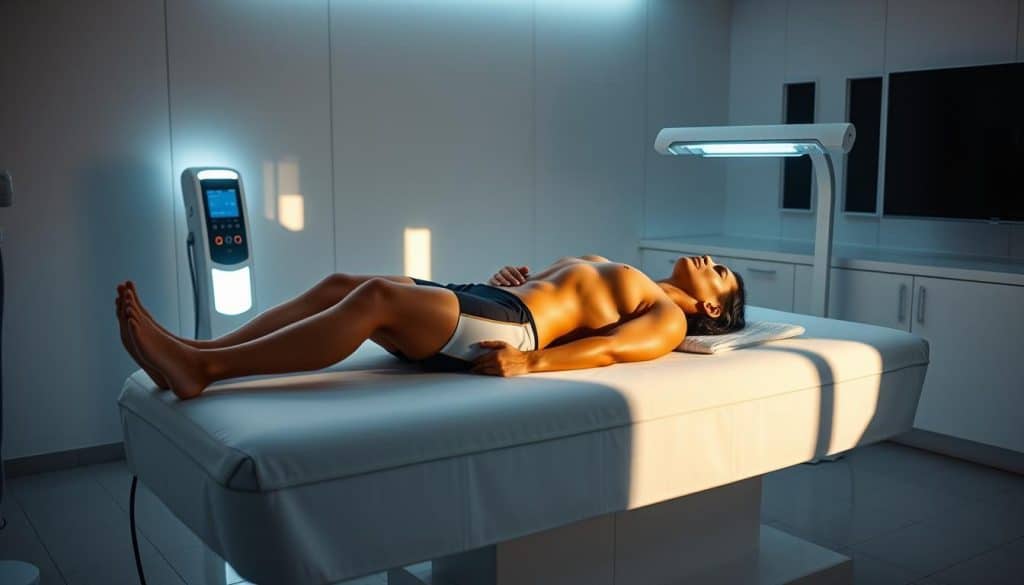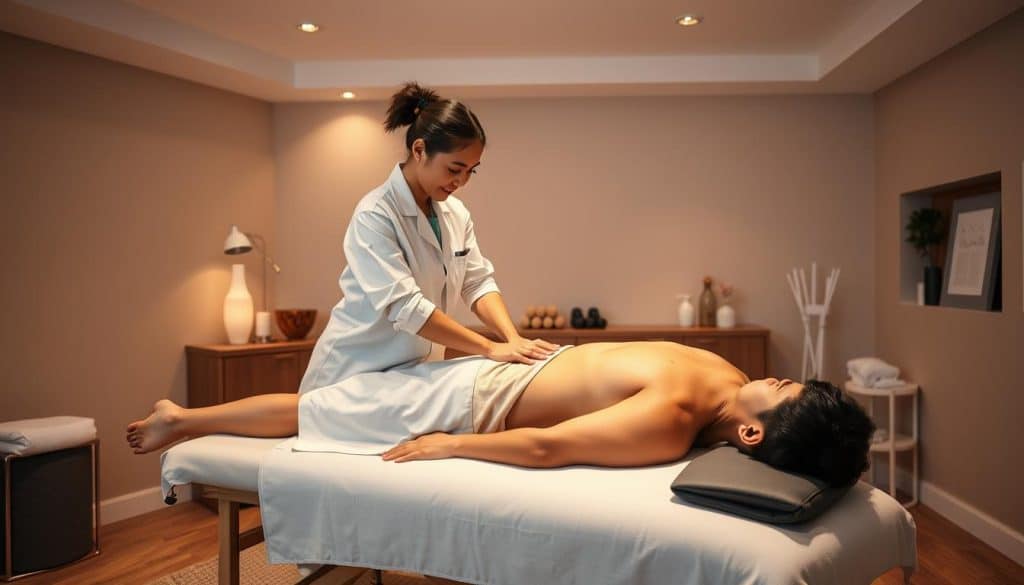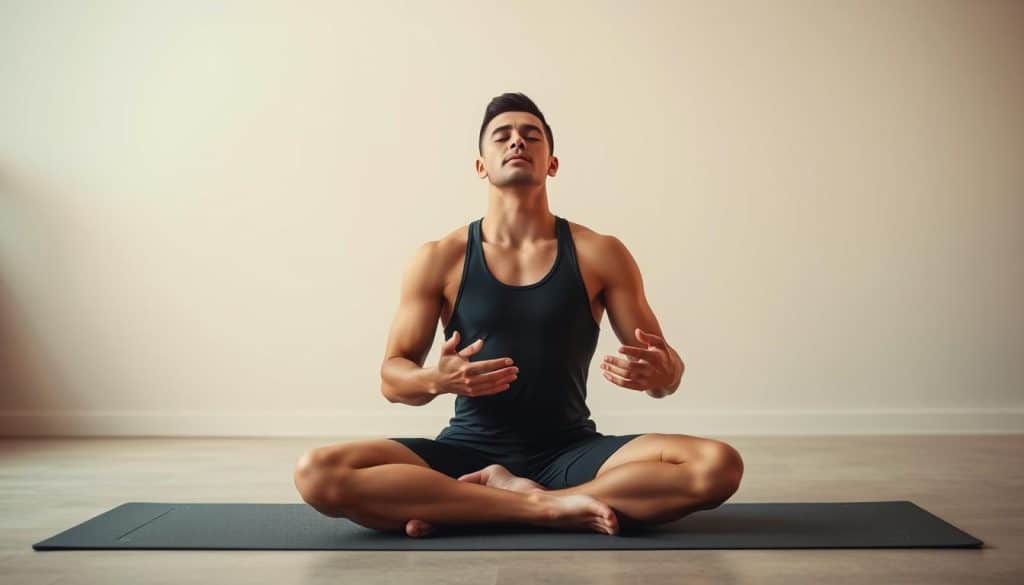Athletes in Canada face big challenges in managing pain and staying at top performance. Riverside Sports Therapy in Calgary, AB, offers new ways to handle pain without surgery. These methods help athletes recover faster and stay strong.
Managing pain for athletes needs smart, tailored approaches. These methods must also avoid causing more harm. Now, athletes can use advanced treatments that help them heal quicker and perform better.
Experts in sports medicine know that the best pain relief for athletes is both effective and gentle. Riverside Sports Therapy has created special plans. These plans help athletes get better fast and safely.
Key Takeaways
- Non-invasive techniques prioritize athlete recovery
- Personalized pain management strategies are critical
- Advanced technologies support athletic rehabilitation
- Calgary-based experts lead innovative treatment approaches
- Mental and physical recovery techniques intersect
Understanding Athletic Pain Management in Canadian Sports
Sports Medicine is key in Canada for athletes, tackling pain and injury prevention. It’s all about keeping athletes in top shape by managing pain well.
Athletes face many pain sources that affect their training and games. They need special care to stay in great physical shape.
Common Sources of Athletic Pain
- Overuse injuries from repetitive movements
- Muscle strains and ligament sprains
- Joint stress from high-intensity training
- Chronic inflammatory conditions
- Micro-trauma from intense physical exertion
Impact on Performance and Recovery
Pain can really cut down an athlete’s performance. If not managed, it can lead to weaker training, less strength, and long-term health issues.
| Pain Impact Category | Performance Reduction | Recovery Time |
|---|---|---|
| Mild Discomfort | 10-20% Performance Decrease | 1-3 Days |
| Moderate Pain | 30-50% Performance Decrease | 4-7 Days |
| Severe Pain | 60-80% Performance Decrease | 2-4 Weeks |
Canadian Sports Medicine Approach
Canadian sports medicine takes a whole-body approach to comprehensive injury prevention. They use top-notch diagnostic tools, tailor-made treatments, and the latest rehab methods to help athletes perform at their best.
By focusing on early care and custom plans, Canadian sports medicine pros help athletes avoid pain, lower injury risks, and stay in top shape.
The Science Behind Non-Invasive Pain Relief Methods
Athletic pain management has seen big changes in recent years. New alternative therapies offer athletes effective ways to recover. These methods are based on a deep understanding of how pain works in the body.
Studies show how these treatments work with the body’s healing processes. They help reduce inflammation and speed up recovery. These methods target specific ways the body feels pain and heals itself.
- Neurological pain modulation techniques
- Cellular-level healing mechanisms
- Biomechanical stress reduction methods
Non-invasive pain relief works by understanding the body’s complex systems. Neurological signaling is key in how athletes feel and manage pain. Special treatments can block pain signals, helping athletes heal faster without surgery.
Canadian sports medicine researchers have led the way in this field. They’ve shown how non-invasive methods can help athletes recover better and avoid long-term damage.
“Pain management is not about eliminating discomfort, but understanding and supporting the body’s natural healing mechanisms.” – Canadian Sports Medicine Research Institute
Athletes can now use proven techniques for pain relief without losing performance. The latest research is making non-invasive pain management even better. This leads to more effective and complete treatments for athletes.
Cold Therapy Techniques for Athletic Recovery
Athletes in Canada are finding natural ways to heal injuries with cold therapy. This method helps with pain, swelling, and healing. It’s a non-invasive way to get better.
Cold therapy is a smart way to handle sports stress and help the body heal. It lets athletes recover faster and avoid long-term injuries.
Cryotherapy Benefits
Cryotherapy has many benefits for athletes looking for natural recovery:
- Rapid inflammation reduction
- Enhanced muscle recovery
- Decreased muscle soreness
- Accelerated healing processes
- Improved circulation
Ice Bath Protocols
Professional athletes follow certain ice bath protocols for better recovery. The key steps include:
- Water temperature between 50-59°F (10-15°C)
- Immersion duration of 10-15 minutes
- Post-bath gradual warm-up techniques
- Consistent implementation after intense training
Localized Cold Treatment Methods
Targeted cold treatments offer precise injury recovery. Athletes use methods like:
- Compression cold wraps
- Targeted ice massage
- Precision cooling devices
- Strategic cold gel applications
By using these cold therapy techniques, athletes can improve their natural recovery. This helps them stay at their best performance.
Heat Therapy Applications in Sports Medicine
Heat therapy is a key tool in Sports Medicine. It helps athletes recover from injuries and improve their performance. Experts and athletes see the big benefits of using heat to ease pain and boost movement.
Heat therapy offers many advantages for athletes looking for pain relief:
- Increases blood flow to muscles
- Reduces muscle tightness
- Speeds up healing and recovery
- Improves flexibility and movement
“Heat is not just warmth—it’s a rehabilitation tool that can revolutionize an athlete’s recovery process.” – Dr. Sarah Reynolds, Sports Medicine Specialist
There are different heat therapy methods for pain management. Experts often suggest:
- Infrared heat treatments
- Warm compression therapy
- Therapeutic heating pads
- Hot water immersion techniques
Using heat therapy right is all about knowing what each athlete needs. Sports medicine experts look at each athlete’s situation. They create heat plans that help recovery and avoid problems.
Non-Invasive Pain Relief Techniques for Athletes
Athletes are always looking for ways to manage pain and recover faster. New non-invasive pain relief methods have changed sports medicine. They offer strong alternatives to old treatments.
Evidence-Based Methods
New non-invasive pain relief techniques are backed by science. They help athletes perform better and recover faster. Some key methods include:
- Specialized soft tissue manipulation
- Targeted compression therapies
- Neuromuscular electrical stimulation
- Advanced stretching protocols
Implementation Strategies
Managing pain well needs a good plan. Athletes can improve by:
- Getting advice from certified sports medicine experts
- Creating treatment plans that fit them
- Using a mix of non-invasive methods
- Keeping an eye on how their body responds
Recovery Protocols
Good recovery plans are key for athletes to manage pain long-term. Customized plans that use different non-invasive methods can boost performance and lower injury risks.
Effective pain relief is not about eliminating discomfort, but understanding and managing the body’s natural healing processes.
Advanced Physiotherapy Approaches in Calgary
Calgary is leading the way in Physical Therapy, giving athletes the latest in injury recovery. Riverside Sports Therapy, in the city’s heart, shows what makes Calgary top for sports rehab.
The city’s physiotherapy scene has changed a lot. It now uses advanced methods that go beyond old-school rehab. These new techniques focus on each athlete’s needs, using precision and skill.
- Biomechanical analysis for targeted intervention
- Advanced manual therapy techniques
- Neuromuscular re-education strategies
- Specialized soft tissue manipulation
Now, Calgary’s injury recovery uses the latest tech to heal faster and perform better. Experts use detailed checks to find injury causes, then make plans just for that athlete.
| Technique | Focus Area | Recovery Impact |
|---|---|---|
| Dynamic Neuromuscular Stabilization | Core Strength | High Performance Restoration |
| Advanced Trigger Point Therapy | Muscle Tension Release | Pain Reduction |
| Functional Movement Screening | Injury Prevention | Performance Optimization |
Riverside Sports Therapy’s approach shows Calgary’s dedication to Physical Therapy. It ensures athletes get the best rehab services.
Electromagnetic Therapy and Pain Management
Athletes are always looking for new ways to manage pain. Electromagnetic therapy is a new method that helps with pain and speeds up recovery.

PEMF technology is a non-invasive treatment for athletic pain. It uses electromagnetic waves to help cells heal and reduce swelling.
PEMF Technology Fundamentals
PEMF technology sends electromagnetic pulses into deep muscle tissues. These pulses start important biological processes:
- Enhanced cellular communication
- Improved blood circulation
- Accelerated tissue repair
- Reduced inflammatory markers
Treatment Protocols
Doctors create special plans for each athlete using electromagnetic therapy. The plans include:
- Initial diagnostic assessment
- Targeted frequency selection
- Precise duration determination
- Consistent treatment scheduling
Research-Backed Results
Studies show electromagnetic therapy works well for athletes. They find faster recovery times and better performance.
| Recovery Metric | PEMF Therapy Impact |
|---|---|
| Muscle Inflammation Reduction | 35-50% Decrease |
| Pain Intensity Reduction | 40-65% Improvement |
| Recovery Time Acceleration | 20-30% Faster |
Athletes looking for new pain management options can try electromagnetic therapy. It’s a non-invasive and effective treatment.
Natural Anti-Inflammatory Solutions for Athletes

Athletes are always looking for natural ways to fight inflammation and boost their performance. In Canada, sports medicine is moving towards holistic pain management. This shift offers athletes new ways to recover and stay well.
There are many natural ways to lessen muscle soreness and aid in healing. Athletes can use several strategies to fight inflammation:
- Dietary interventions with anti-inflammatory foods
- Herbal supplements with natural healing properties
- Strategic nutritional supplementation
- Lifestyle modifications supporting recovery
Nutrition is key in managing athletic inflammation. Some foods can greatly reduce inflammation in the body. Omega-3 rich fish, turmeric, ginger, and berries are powerful natural remedies for athletes.
| Natural Anti-Inflammatory Food | Key Benefits |
|---|---|
| Salmon | High omega-3 content, reduces muscle inflammation |
| Turmeric | Powerful antioxidant, supports joint health |
| Blueberries | Rich in antioxidants, accelerates muscle recovery |
| Ginger | Reduces muscle pain, supports circulation |
Herbal supplements also help athletes looking for natural remedies. Curcumin, boswellia, and bromelain show great promise in fighting inflammation naturally.
Natural healing represents the future of sports medicine, empowering athletes to recover faster and perform stronger.
Modern Sports Massage Techniques
Physical therapy for athletes needs new ways to help muscles recover and manage pain. Sports massage is key for athletes wanting to perform at their best and heal fast. Athletes in Canada are using advanced massage techniques to stay in top shape.

Modern sports massage is more than just relaxing. It uses special techniques to focus on certain muscles, boost blood flow, and speed up healing.
Deep Tissue Benefits
Deep tissue massage offers many benefits for athletes:
- Reduces muscle tension and chronic pain
- Breaks down scar tissue and adhesions
- Improves range of motion
- Enhances blood flow to damaged muscle groups
Recovery Enhancement Methods
Physical therapy experts use advanced massage methods for injury recovery. These include:
- Myofascial release techniques
- Trigger point therapy
- Neuromuscular manipulation
- Active recovery massage protocols
Athletes can cut down recovery time with targeted massage. Specialized techniques help with immediate pain and support long-term muscle health and performance.
Acupressure and Athletic Performance

Athletes are always looking for ways to get better and feel less pain. Acupressure is a non-invasive method that helps athletes by applying pressure to certain points on the body.
Acupressure works by stimulating specific points to help the body heal and function better. It targets areas that can help athletes recover faster and perform better.
- Reduces muscle tension and stress
- Improves blood circulation
- Accelerates recovery time
- Enhances natural pain management
Canadian sports medicine experts see acupressure as a great option for athletes. Applying precise pressure can start the body’s healing process. This helps athletes stay in top shape without needing surgery or other invasive methods.
Some important acupressure points for athletes include:
- Large Intestine 4 (LI4): Manages pain and reduces inflammation
- Liver 3 (LV3): Supports muscle recovery
- Stomach 36 (ST36): Boosts energy and endurance
Many professional athletes in Canada are using acupressure in their training and recovery. They see it as a way to improve their performance naturally and holistically.
Riverside Sports Therapy’s Innovative Treatment Approaches
In the heart of Calgary, Riverside Sports Therapy is a top spot for Sports Medicine and Non-Invasive Pain Relief. It’s known for its groundbreaking healing methods that boost athletic performance and aid in recovery.
Athletes looking for top-notch care find a unique approach at Riverside. It combines advanced sports medicine with personalized recovery plans.
Specialized Athletic Programs
Riverside Sports Therapy has programs for every athlete’s needs:
- Comprehensive biomechanical assessments
- Customized rehabilitation strategies
- Performance optimization training
- Advanced pain management techniques
Expert Rehabilitation Team
The clinic’s team is filled with experts in athletic recovery. They include:
- Certified Sports Medicine Physicians
- Advanced Physical Therapists
- Sports Rehabilitation Specialists
- Regenerative Medicine Experts
Together, they create new, non-invasive pain relief methods. This ensures each athlete gets a treatment plan that works best for them.
Therapeutic Ultrasound Applications
Therapeutic ultrasound is a new method in physical therapy for athletes. It uses high-frequency sound waves to heal deep tissue. This helps reduce muscle pain.
The main advantages of therapeutic ultrasound are:
- Enhanced tissue repair
- Reduced inflammation
- Accelerated recovery time
- Improved blood circulation
Canadian sports medicine experts see ultrasound as a key non-invasive treatment. Deep tissue penetration lets them target specific areas. This makes it a vital part of physical therapy.
“Ultrasound therapy transforms how we approach athletic recovery and pain management” – Canadian Sports Medicine Association
Physical therapy clinics in Canada are using ultrasound more. It creates tiny vibrations that help cells repair. This helps athletes heal faster and better.
Athletes with chronic muscle pain, ligament injuries, or joint stiffness can greatly benefit. By using ultrasound with other treatments, sports medicine experts make recovery plans for each athlete.
Movement-Based Pain Relief Strategies
Athletic performance and injury prevention depend on smart movement techniques. These methods help manage pain. Professional athletes and sports medicine experts agree on the value of targeted exercises and corrective actions.
Effective movement strategies change how athletes deal with pain. They focus on body mechanics and precise corrections.
Essential Mobility Exercises
Athletes use specific mobility exercises to prevent injuries and improve performance. Key techniques include:
- Dynamic stretching routines
- Joint range-of-motion drills
- Functional movement screening
- Proprioceptive neuromuscular facilitation
Corrective Techniques for Athletic Performance
Targeted corrective techniques help athletes fix biomechanical imbalances. This reduces injury risks. These methods involve:
- Postural alignment assessments
- Muscle activation protocols
- Kinetic chain optimization
- Neuromuscular re-education
Using movement-based strategies can greatly improve an athlete’s injury prevention and performance.
“Movement is the ultimate medicine for athletic longevity and peak performance.” – Sports Medicine Research Institute
Integration of Mental Techniques for Pain Management
Athletes in Canada are now seeing the value of holistic pain management. Mental techniques are key in handling physical pain and boosting performance. The link between the mind and body is vital in pain management.
Managing pain goes beyond just physical treatments. Mental methods give athletes strong tools to deal with pain. These methods teach the brain to handle physical feelings differently.
- Mindfulness meditation helps athletes develop greater pain tolerance
- Visualization techniques can reduce perceived pain intensity
- Cognitive behavioral strategies reframe pain experiences
Psychological interventions offer athletes new ways to manage pain. Important mental techniques include:
- Guided imagery
- Breathing control exercises
- Stress reduction practices
- Positive self-talk strategies
“The mind is a powerful tool in pain management. By training mental resilience, athletes can transform their pain experience.” – Sports Psychology Research
Canadian sports medicine experts are adding these holistic methods to pain management plans. Athletes who master mental techniques see big improvements in recovery and performance.
Technology-Driven Recovery Methods in Canadian Sports
The world of Sports Medicine is changing fast, thanks to new technologies. These innovations are making Injury Recovery better for athletes in Canada. They are changing how athletes get better and perform better.
Canadian sports experts are using new tech to help athletes heal faster and perform better. These new methods are changing how sports medicine and injury care work.
Latest Innovations in Athletic Recovery
- Wearable Biometric Tracking Devices
- AI-Enhanced Rehabilitation Platforms
- Advanced Electromagnetic Therapy Systems
- Real-Time Muscle Activation Monitoring
New recovery tech gives athletes a deep look at their health. Precision tracking and data-driven interventions are now common in sports rehab.
Implementation Guidelines for Tech-Driven Recovery
| Technology | Recovery Application | Performance Impact |
|---|---|---|
| Biometric Wearables | Real-time Muscle Strain Monitoring | Reduced Injury Risk |
| AI Rehabilitation Platforms | Personalized Recovery Protocols | Faster Healing Timelines |
| Electromagnetic Therapy | Accelerated Tissue Repair | Enhanced Cellular Recovery |
Experts say to slowly add new tech to recovery plans. Athletes should team up with trained experts to get the most out of these new tools.
Conclusion
Athletes in Canada are finding new ways to manage pain without surgery. They are using holistic methods to improve their sports medicine. This means they can perform better and recover faster without surgery.
Riverside Sports Therapy in Calgary is leading this change. They use the latest technology, manual therapies, and custom recovery plans. This helps athletes get the best pain management, improving both their body and mind.
These non-invasive pain relief techniques are changing the game for athletes. They offer a way to heal and perform at the highest level without surgery. Athletes can now manage pain and recover better, keeping their bodies in top shape.
If you’re looking for help with pain management, call Riverside Sports Therapy at (403) 283-7551. Their team of experts will create a plan just for you. They’ll help you reach your performance goals.
